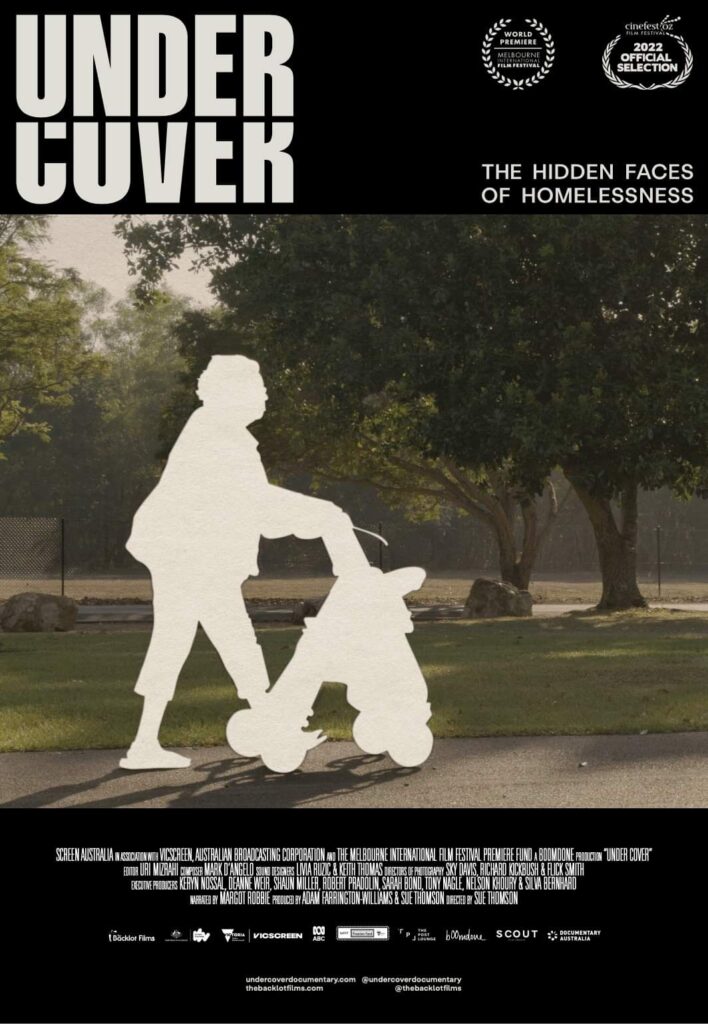Sue Thomson’s eye-opening documentary Under Cover presents the plight of the largest growing cohort of homeless people in Australia; women over the age of 50. It gives the audience access to the lives of women living in precarious situations, provides statistical data, discusses the failure of neoliberalism in Australia to cope with the growing crisis of homelessness, and discusses the myriad reason that women of a certain age are at risk. What Under Cover fails to do is get as righteously angry about the situation as it should. The documentary, narrated by ‘Lucky Australian’ Margot Robbie, leaves a great deal for the viewer to infer rather than stating why the situation is untenable for women.
“Homelessness is loss and absence” a title card suggests. Realistically it’s far more than that. It’s constant anxiety, a lack of safety, a failure of government policy, and a frankly ignored aspect of contemporary Australian society. There are government bodies trying to combat the issue but much of the work falls on NGOs and (often faith-based) charities. The fact that over 405,000 women are homeless or facing homelessness is not a statistic anyone should ignore, and the gendered implications of why women are more at risk are complex and speak to a wider issue of patriarchal dominance in society. Women of a certain age will have taken time out of the work-force to raise families and are less employable than their male counterparts. There is also the scourge of domestic violence. Although Thomson chooses some subjects who have been victim to abuse from men, she doesn’t look closely enough at the issue.
Thomson’s subjects range from women who always lived on the periphery of society, whether that was through familial trauma and dispossession or through disability. She also chooses to focus on women who have chosen to buck the social norms and live a deliberate peripatetic life. One woman is a “grey nomad” who has sunk all of her super into a van she lives and travels in. Another is an artist who lost her residence during the COVID lockdown because she was no longer able to pay her rent through the sale of her art. Yet another is a German immigrant who declares she wants to be a loner and live in her car. The thread that connects these women is they come from around NNSW. What the documentary doesn’t mention is the extreme rental crisis in the area caused by the influx of tourism and “influencer culture” in the region.

For a couple of the documentary subjects homelessness came as a complete surprise. They lived a seemingly middle-class existence until one day it all came crashing down. One woman trusted her husband with all the finances until he suddenly let her know they were broke and then left her. Another was a successful designer in Sydney but her bipolar diagnosis meant she was unable to sustain her career. Going from a state of security to one of homelessness can happen to anyone at any time – it may be a conflation of factors, or it may be simply a bit of bad luck. No one is safe.
One voice that speaks with fire is queer Indigenous writer Claire G. Coleman. The now award-winning author spent ten years homeless. She links the issue to colonialism and the displacement of First-Nations people (a sentiment that is echoed by another interviewee whose status as an Indigenous woman was a factor in her chaotic childhood but was also denied the opportunity to pass her culture on to her own family).
It wasn’t lost on this viewer that when the head of a charitable NGO meets Lord Mayor Sally Capp in Naarm that the shots of the Melbourne CBD showed hostile architecture – in effect what is known as homelessness deterrence technology. Public benches that have rails separating the bench to discourage people from sleeping on them for example. Sally Capp decries the way we ignore and dehumanises the homeless, yet her domain is filled with devices to make their lives more difficult.
Homeless women are less likely to be seen sleeping rough states the documentary, and thus it’s assumed that mostly men are affected by the issue. What the documentary doesn’t say is that women sleeping in public places are more likely to be sexually abused and beaten, so they try to find cars to sleep in.
Thomson does manage to make the audience aware of the looming crisis for older women in Australia, and gives the reasons for it happening, yet the documentary lacks grit. Instead of pulling her punches by concentrating on a character study of the women she has chosen to document, Thomson could have made a blistering and necessary film that demands the issues be dealt with through multiple communicating methods.
Under Cover is a missed opportunity to force direct action. The documentary will have an Impact Campaign that will hopefully engender productive conversations about the increasing dispossession of older women in Australian society. Without adequate safety nets, so many will fall through the cracks, especially when we are dealing with a two-party system that deliberately refuses to raise the rates of social security and makes it nigh on impossible for disabled people to gain access to essential services like the NDIS. The ways to tackle homelessness are as multi-faceted as the reasons that people find themselves in the situation. Sue Thomson’s documentary may shock some people who have never considered how insecure their sheltered status is, but it is only a small spark in an already huge inferno that must be attended to immediately.
Director: Sue Thomson



